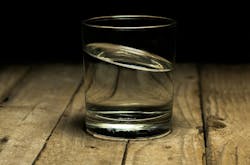Chlorine Taste in the Customer's Drinking Water?
Updated 8/24/21
Chlorine produces bacteria-free water and eliminates algae and slime. It also removes hydrogen sulfide from ground water (wells and springs) and eliminates iron bacteria (cenothrix), which are associated with objectionable odor and taste.
Does Chlorine Have a Smell?
Despite these important facts, some people still object to chlorine in their drinking water. Comments such as “I don’t like the way chlorine makes my water taste” are common.
The bad taste actually is due to an insufficient residual or the lack of chlorine in their water. If you can smell or taste chlorine in your drinking water, there isn’t enough chlorine residual in it. The proper dosage of chlorine to maintain the required minimum residual of “free” chlorine is the important key. If the residual falls below the “free” minimum, the reforming of chlororganics and chloramines (the taste and odor producing part of the disinfection process) takes place as a result of increased contamination (chlorine demand). The increased levels can be a result of a main break, cross connection, increased bacteria growth from a dead-end line or a combination of all of these. (There are other possibilities as well.)
Does Bottled Water Have Chlorine in It?
There are some who favor switching to bottled water to avoid drinking chlorinated water. Consumers may be startled to learn that there may be some brands of bottled water that contain cancer-causing chemicals in amounts that exceed federal standards. If these chemicals are found in bottled water, there are no regulations that require the public to be notified. The Kansas Department of Health and Environment conducted a study of 80 bottled water samples that were collected from retail stores and manufacturers between March 21 and May 22 of 1994. In 15 percent of the bottled water, cancer-causing chemicals were discovered. Nine contaminants were found in amounts that exceed federal limits. The results weren’t made public until 14 months later.2
When the same type of tests is given to a municipal or rural water district producing potable drinking water, the public must be informed immediately of any contaminants found in excess of the U.S. Environmental Protection Agency’s limits. The water district then would be tested on a more frequent basis. The customers in the affected district are encouraged to drink bottled water but the bottled water also may be contaminated.2
Many bottled water brands begin as tap water from a public water system with the chlorine residual removed. After this, it is given a two-year or more shelf life. There are little or no restrictions on the environment in which the water is stored.
The complete elimination of deadly diseases such as cholera, typhoid and others now is taken for granted. These eliminations can in part be attributed to the effectiveness of chlorinated water. Some people comment that they would rather wait until something happens and they are ordered to disinfect instead of taking preventative measures. The deaths in Walkerton, Ontario, Canada, in June 2000, were caused by E. coli as a result of run-off from a cattle ranch. No preventative measures had been taken and several lives were lost. A good thing to keep in mind is what goes in the ground today is what you will drink tomorrow. Isn’t that reason enough to see a need for disinfection?
Chlorine has been available since the early 1900s and has overwhelmingly proved its effectiveness since that time. Chlorine is as important to pure water as the polio vaccine has been to the public health.
Chlorination is used for taste and odor control, water main sterilization, algae and slime control, hydrogen sulfide removal, iron and manganese, cooling towers, low pressure drip irrigation systems and poultry drinking/processing water to name a few uses.
Water quality can be obtained by many forms of processes and alternative means of disinfection. However, a minimum residual level of the disinfectant has to be provided at the furthest distance from the injection point. So far chlorine is the only disinfectant approved that provides this required measurable residual amount. Clean, efficient, pure 100 percent chlorine is available only in gaseous form, and it has the safest accident record. Calcium hypochlorite at 65 percent and sodium hypochlorite containing 10 to 15 percent available chlorine are perceived as being safer. However, their easy-to-use containers allow for accidents and the possibility of allowing contamination even during the manufacturing process.
Chlorine in drinking water is mandatory in most states. In those where it is not, it is important to remember the benefits, cost effectiveness and safety record of chlorine gas (the purest form of chlorine) when fed through an all vacuum mounted chlorinator.
